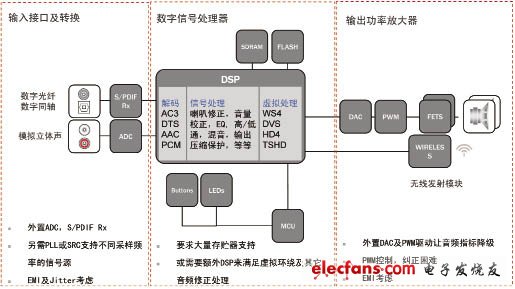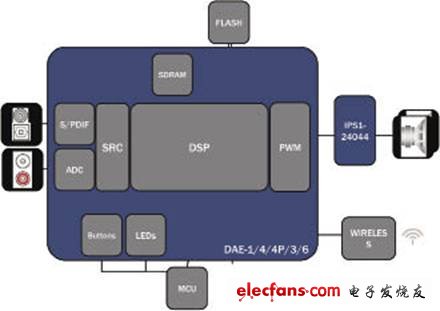Traditional bar sound structure
First of all, the traditional bar sound system architecture is simply divided into three parts: input interface and conversion, digital signal processor and output power amplifier, as shown in Figure 1.

Figure 1 Structure of a traditional bar sound system
Input interface and conversion: An external ADC (analog-to-digital converter) converts the analog stereo signal to a digital signal. S / PDIF Rx is responsible for converting digital optical fiber and digital coaxial signals. In this way, additional PLL or SRC is needed in the design to support signal sources with different sampling frequencies. Not only that, this design is not ideal in terms of EMI and Jitter.
Digital signal processor: requires a lot of memory support, requires additional MCU to handle the work of keys or display screen, or requires additional DSP to meet the needs of virtual surround audio correction processing.
Output power amplifier: The signal output from the DSP requires an external DAC and PWM driver to degrade the audio specifications. PWM control corrects difficulties. Similarly, it is not ideal to consider EMI. If it is a system with a wireless subwoofer, you also need the DSP to generate the subwoofer signal.
In total, up to a dozen components are used in the traditional sound bar system architecture.
D2Audio architecture
After comparing the Intersil D2Audio Simply Smarter SoundBar architecture with the traditional architecture, it can be found that the D2Audio architecture can reduce the total number of components by about half. The architecture of D2Audio Simply Smarter SoundBar is shown in Figure 2.

Figure 2 Intersil D2Audio Simply Smarter SoundBar architecture
From this block diagram, you can see that the input part is basically contained in the chip, so the digital optical fiber or all can be processed by this chip. Built-in SRC, support signals of different sampling frequencies, only need Flash as memory. A simple system may not require an MCU. In terms of DSP, the architecture includes a complete series of DSPs: DAE1 / 3/4/6, which can support different processing application requirements. Controllable GPIO supports interface control, built-in PWM driver, you can directly push the post-stage power amplifier, you can also use DSP to adjust the PWM to optimize the output index, improve efficiency, EMI and audio performance are ideal. Intersil IPS directly drives the post-stage, supporting different power and configuration requirements. Post-processing I2S / SPDIF output meets different wireless content needs.
NMOS English is called N-Metal-Oxide-Semiconductor. It means an N-type metal-oxide-semiconductor, and a transistor having such a structure is called an NMOS transistor. The MOS transistor has a P-type MOS transistor and an N-type MOS transistor. An integrated circuit composed of a MOS transistor is called a MOS integrated circuit, and a circuit composed of an NMOS is an NMOS integrated circuit. A circuit composed of a PMOS transistor is a PMOS integrated circuit, and a complementary MOS circuit composed of two types of NMOS and PMOS transistors, that is, a CMOS circuit .
N Channel Mosfet,N Channel Power Mosfet,High Voltage N Channel Mosfet,N Channel Transistor
Dongguan Agertech Technology Co., Ltd. , https://www.agertechcomponents.com